Step into a world of enchantment and history as we explore the magical Gothic Quarter in Barcelona.
From stunning architecture to vibrant street art, this captivating neighborhood offers an incredible journey through time, culture, and imagination. Are you ready to discover the hidden gems and breathtaking sights that await you? Let’s dive in!
- Uncover the secrets of Barcelona’s Gothic Quarter with a visit to its captivating attractions!
- Explore Las Ramblas, MUHBA and Temple d’August for an unforgettable experience.
- Immerse yourself in Catalan culture with street art, fairytale bars & traditional dances!
Unveiling the Barcelona Cathedral
One of the most remarkable landmarks in the Gothic Quarter is the stunning Barcelona Cathedral, also known as the Cathedral of the Holy Cross and Saint Eulalia.
Built between the 13th and 15th centuries, this architectural masterpiece showcases the intricate Catalan Gothic style and is dedicated to Saint Eulalia, the patron saint of the city. Situated near Barcelona’s Roman Temple, the cathedral stands as a testament to the rich history of this captivating quarter.
Step inside to find an awe-inspiring cloister, housing 13 white geese symbolizing the 13 years of Saint Eulalia’s life. Legend holds that the cathedral’s stability depends on the presence of each goose. Be sure to explore the narrow streets of the Gothic Quarter to discover the cathedral’s patios and gorgeous cloisters, each adorned with intricate details that will leave you in awe.
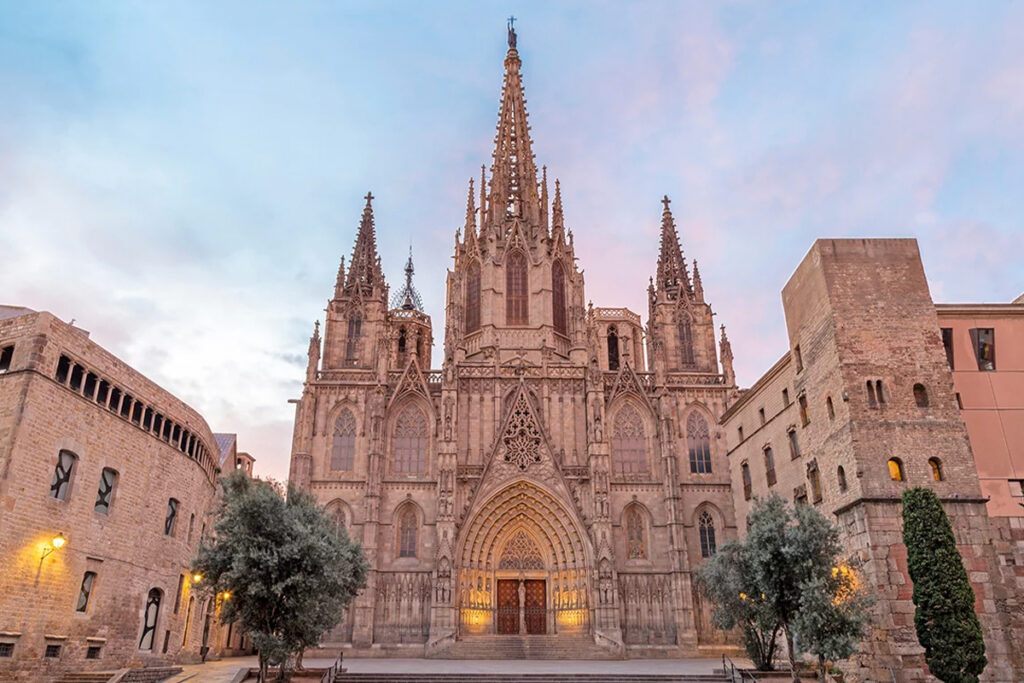
Remember, you can visit the cathedral for free between 8 a.m. and 12:45 p.m. or 5:45 p.m. and 7:30 p.m. While you’re there, make your way to the roof and marvel at sweeping views across Barcelona, including the famous Plaça de Catalunya. And if you’re looking for that perfect photo, the Barcelona Cathedral is absolutely amazing under the magical light of dusk.
Strolling Down Las Ramblas
As you continue your adventure through the Gothic Quarter, you’ll inevitably find yourself on the iconic street of Las Ramblas. This bustling avenue separates the Barrio Gótico from the Raval neighborhood, and offers a lively atmosphere with incredible street performers and attractions. As you stroll down the vibrant street, you’ll truly feel the energy and spirit of Barcelona. Just off Las Ramblas, you can explore the narrow street that leads you deeper into the heart of the Gothic Quarter.
But exercise caution while wandering around Las Ramblas; it is infamous for its tourist traps. To avoid overpriced souvenirs and food, head to the nearby Boqueria Market for delicious fruit smoothies, succulent Iberian ham, and mouthwatering seafood tapas. And when the sun goes down, immerse yourself in the exciting nightlife of the Gothic Quarter, where you’ll find everything from dive bars and dance clubs to sophisticated cocktail lounges.
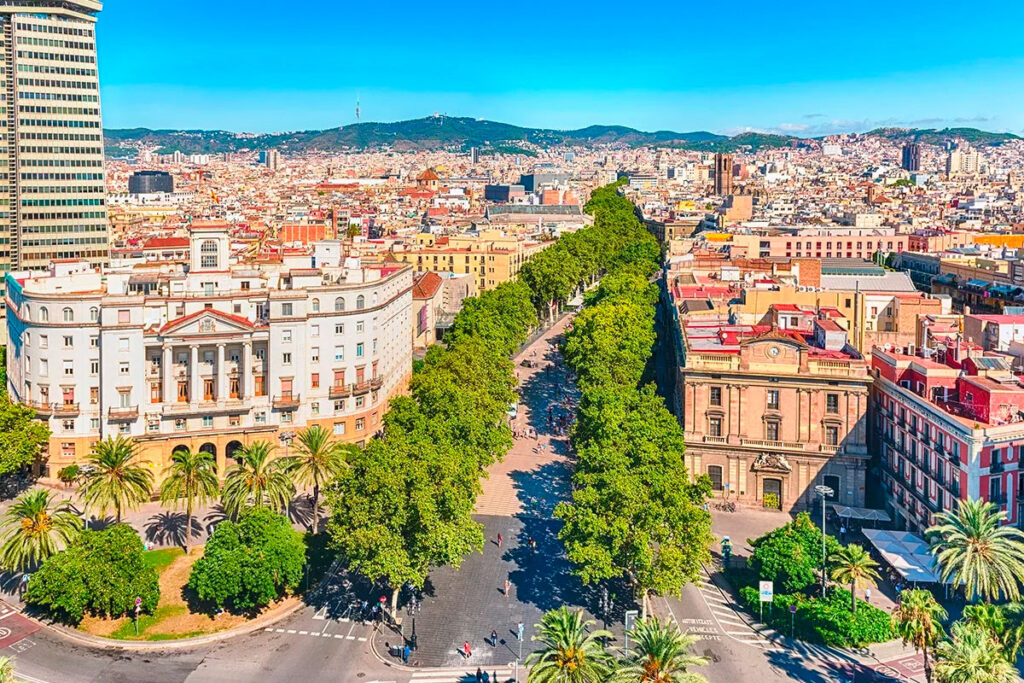
Seek out the Royal Square, also known as Plaça Reial, for a truly distinctive experience, a lively square flanked by the stunning lampposts designed by a young Antoni Gaudi. Here, you can sit at the central fountain and watch the world go by, or indulge in a delicious Barcelona paella dinner at Les Quinze Nits. With so much to see and do, Las Ramblas and its surrounding areas, including the charming Sant Felip Neri Square, are sure to leave a lasting impression.
Uncovering the Secrets of Pont del Bisbe
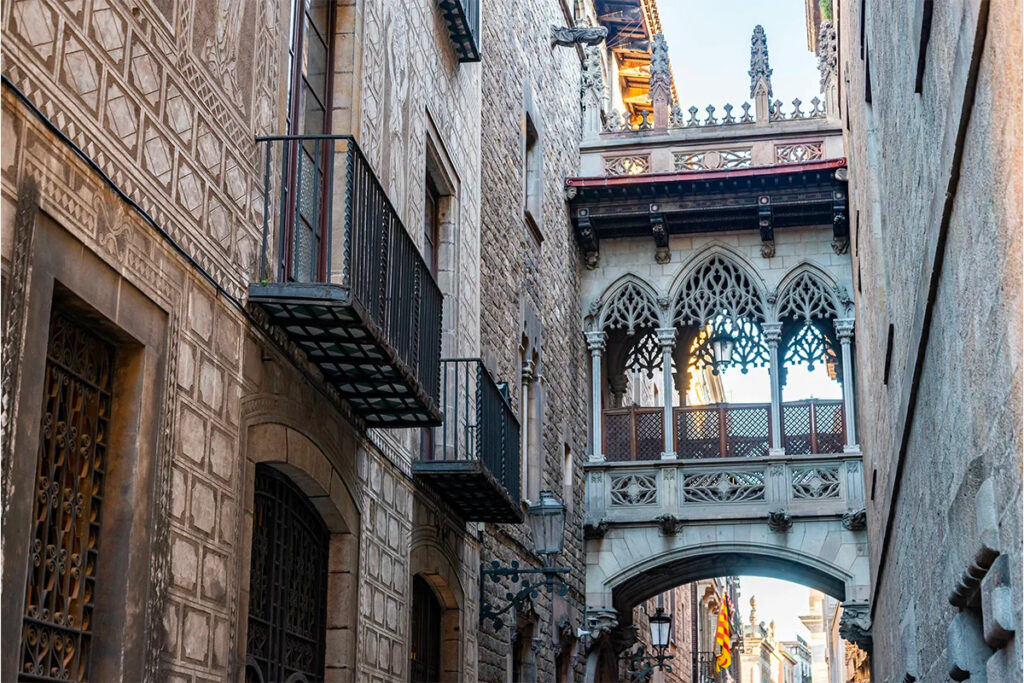
Tucked away within the winding streets of the Gothic Quarter is the picturesque Pont del Bisbe, a Gothic-style bridge designed by Joan Rubió i Bellver. This ornamental bridge, also known as Bishop’s Bridge, connects the Palau de la Generalitat with the Casa dels Canonges, adding an air of mystery and intrigue to the quarter.
But what truly sets Pont del Bisbe apart is the hidden skull and dagger sculpture underneath the arch. According to legend, the embittered architect left this macabre detail as a curse after the city rejected all his other proposals. Today, this semi-hidden sculpture has become a popular spot for photography and exploration, as visitors search for the secrets hidden within the Gothic Quarter. While unraveling the secrets of Pont del Bisbe, bear in mind that the Gothic Quarter not only offers captivating beauty but is also steeped in legends and stories waiting to be unearthed. Let your curiosity guide you as you explore the enchanting streets of this remarkable neighborhood.
Tracing Picasso’s Footsteps in the Gothic Quarter
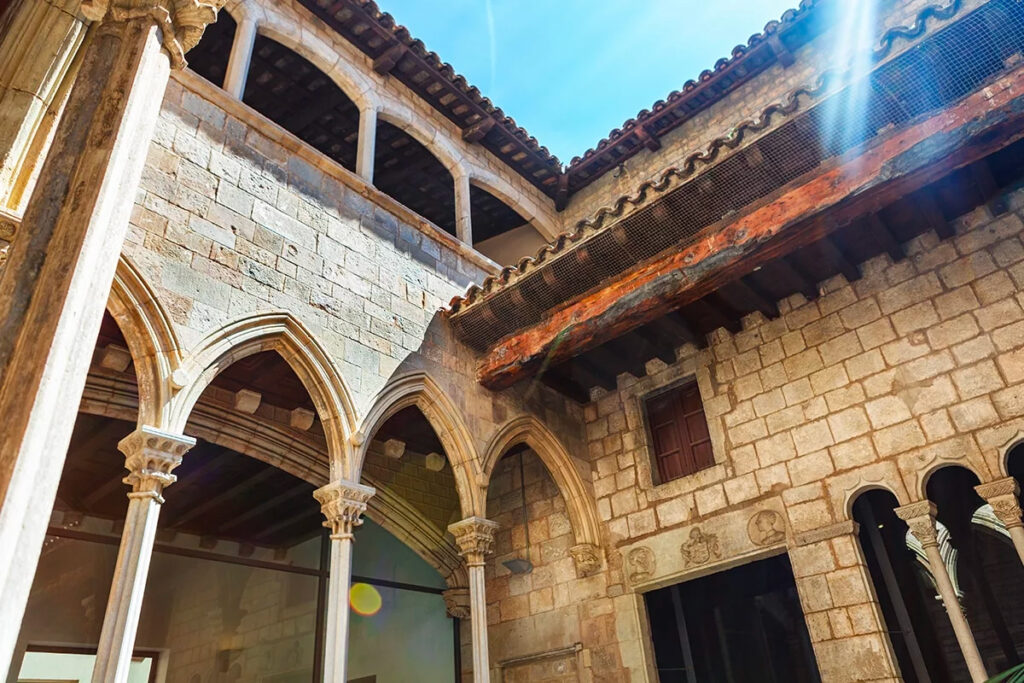
The Gothic Quarter was not only home to magnificent architecture and hidden legends, but also to the renowned artist Pablo Picasso. He studied at the Fine Arts School on Carrer d’Avinyó, a bustling street of questionable morals during his time. As you walk the same streets that inspired Picasso, you’ll begin to see the rich tapestry of culture and history that influenced his work.
One of Picasso’s most famous works, Les Demoiselles d’Avignon, was inspired by the colorful and vibrant characters he encountered on Carrer d’Avinyó. And just a few steps away, you’ll find the Association of Catalan Architects building, where a sand-cast frieze by Norwegian artist Carl Nesjar brings new life to one of Picasso’s original drawings. Further exploration of the Gothic Quarter reveals the Picasso Museum, a treasure trove of the artist’s works and a testament to his lasting impact on the art world. Tracing Picasso’s footsteps through the labyrinthine streets brings you closer to understanding the man behind the masterpieces and the city that nurtured his prodigious talent.
Stepping into a Fairytale at El Bosc de les Fades
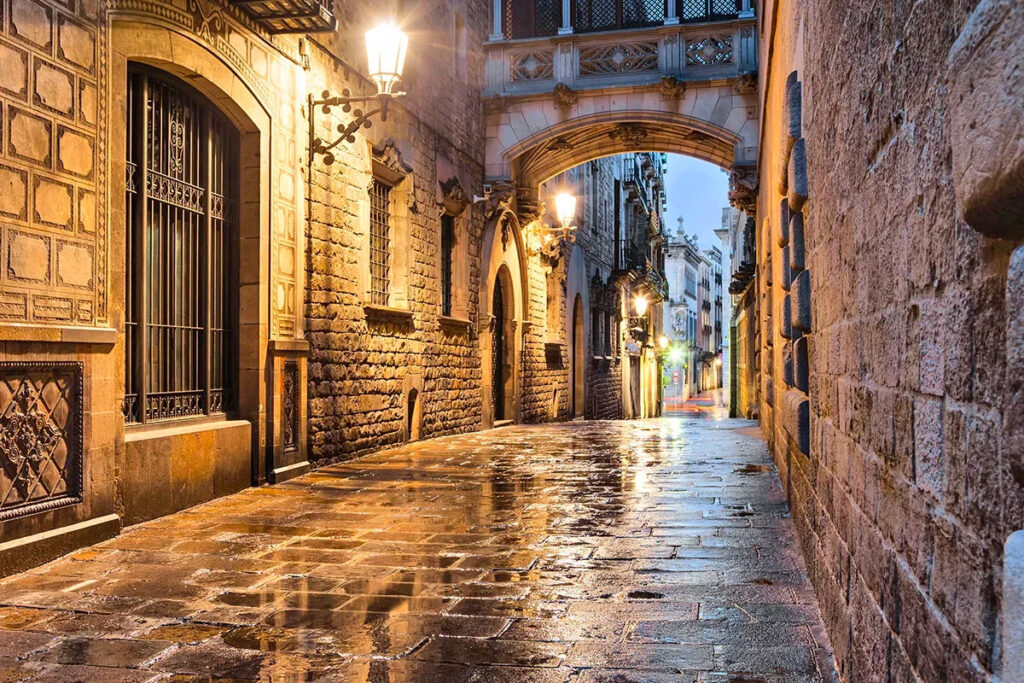
After exploring the beautiful streets and landmarks of the Gothic Quarter, you may find yourself in need of a refreshing drink and a place to unwind. Look no further than El Bosc de les Fades, a unique and enchanting bar that transports visitors into a magical forest setting. Located in the courtyard of the Wax Museum on Passatge de la Banca, this whimsical bar is the perfect escape from the bustling city streets.
As you step inside El Bosc de les Fades, you’ll be greeted by a mystical ambiance complete with twinkling lights, dreamy foliage, and the soft sounds of a babbling brook. This enchanting atmosphere is the perfect backdrop for sipping on reasonably priced drinks with friends or a loved one. Whether you seek a tranquil hideaway or an enchanting evening, El Bosc de les Fades promises a memorable experience. that will leave you feeling like you’ve stepped into a fairytale. So, gather your friends and embark on a journey into the enchanted forest of El Bosc de les Fades.
Delving into History at the Barcelona History Museum (MUHBA)
For history enthusiasts, a visit to the Barcelona History Museum (MUHBA) is an absolute must. This immersive museum showcases 2000 years of Barcelona’s history, providing a fascinating glimpse into the city’s past. One of the most remarkable features of the museum is the underground walk through ancient Roman streets, where you can see old wine shops, homes, and even a guard tower.
The MUHBA provides a memorable journey into the city’s rich history. From the early days of the Roman colony to the vibrant modern metropolis we know today, the museum provides an unparalleled journey through time. The best part? Entrance to the museum is free on Sunday afternoons after 3 p.m.. So, be sure to take advantage of this amazing opportunity to explore the captivating history of Barcelona and the Gothic Quarter.
Finding the Hidden Gem: Temple d’August

As you wander through the narrow streets of the Gothic Quarter, you may stumble upon a hidden gem nestled within a medieval courtyard behind the Barcelona Cathedral. The well-preserved Temple d’August, also known as Barcelona’s Roman Temple, is a testament to the city’s Roman heritage and provides a fascinating glimpse into the past of this ancient Roman city.
This ancient Roman temple, with its impressive columns standing over 2000 years old, is a striking contrast to the surrounding medieval architecture and nearby Roman walls. A visit to the Temple d’August is like stepping back in time, offering a unique opportunity to connect with the history of the city. The most enticing aspect? You can enter the temple and its courtyard without spending a penny. So, be sure to seek out this hidden treasure and immerse yourself in the captivating history of Barcelona’s Gothic Quarter.
Marveling at the Gothic Quarter’s Vibrant Street Art
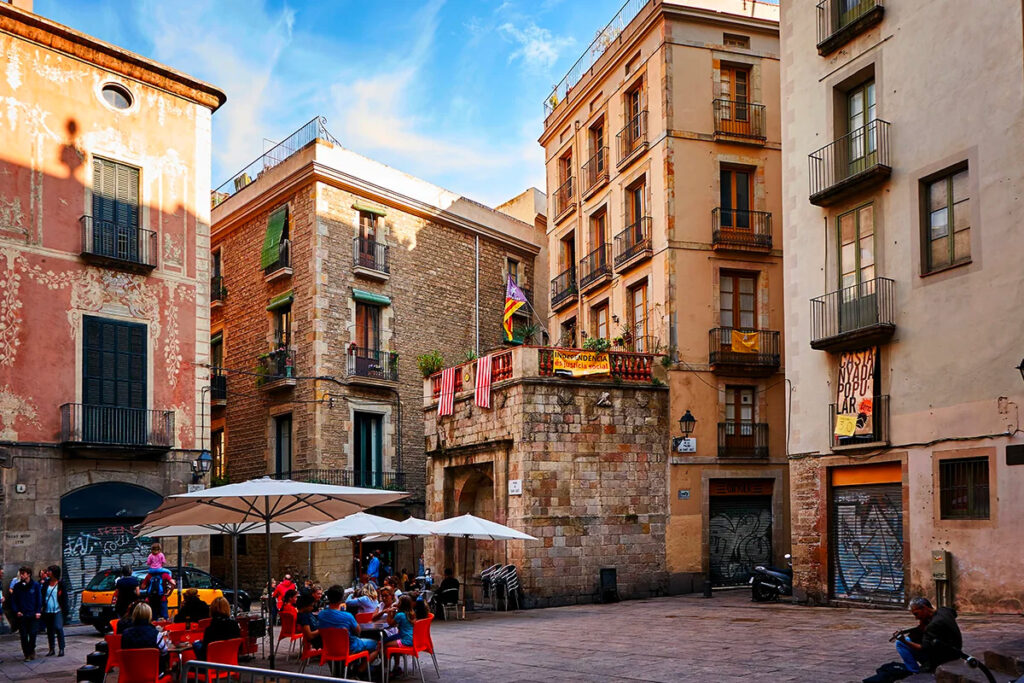
As you explore the enchanting streets of the Gothic Quarter and the nearby Jewish Quarter, you’ll quickly discover the thriving street art scene that adds a vibrant splash of color to the historic neighborhoods. With a mix of colorful murals, stunning graffiti, and thought-provoking installations, the Gothic Quarter showcases the creative spirit of local artists.
One of the most famous murals in the area is “The World Begins With Every Kiss,” a captivating piece that adds a touch of romance to the streets. As you wander through the winding streets, be on the lookout for works by renowned street artists such as Pez, Aryz, Kenor and Sixe Parades/Sixeart.
The street art in Barcelona’s Gothic Quarter is not only a visual feast for the eyes but also a reflection of the dynamic culture and creative energy that makes Barcelona such a vibrant and unique city. Therefore, don’t miss out on appreciating these artistic creations while journeying through the charismatic streets of the Gothic Quarter.
Embarking on a Guided Tour of the Barrio Gótico
If you want to delve even deeper into the rich history and fascinating landmarks of the Gothic Quarter, consider embarking on a guided tour with a professional guide. These 2.5-hour tours provide an unparalleled opportunity to learn about the history and political situation of Barcelona, as well as the iconic landmarks that make the Gothic Quarter such a captivating destination. Discover the charm of the quarter in Barcelona that has captivated visitors for centuries.
One of the many benefits of a guided tour is the chance to gain insider knowledge and uncover hidden gems that may be easily overlooked. From the stunning architecture to the vibrant street art scene, a guided tour will enhance your appreciation of the Gothic Quarter and its many treasures. Given the wealth of sights and experiences in the Barrio Gótico, a guided tour can be instrumental in maximizing your visit. So, lace up your walking shoes and embark on an unforgettable journey through the captivating streets of the Gothic Quarter.
Experiencing Traditional Catalan Culture: The Sardana Dance
No visit to the Catalan capital would be complete without experiencing the traditional Catalan folk dance, the Sardana. Performed every Sunday in front of the Barcelona Cathedral, this lively dance showcases the vibrant culture and spirit of the region and offers a unique glimpse into the customs and traditions of Catalonia in the Gothic Quarter.
Originating in the Pyrenees region of Spain, the Sardana has been performed for centuries and is now a symbol of Catalan culture and identity. As you watch the dancers gracefully move in a circle, their hands intertwined, you’ll feel a connection to the people and history of this enchanting city. Thus, remember to schedule in and join the local populace in their heritage celebration via the lively and alluring Sardana dance. It’s a truly unforgettable experience that will leave you with a lasting memory of your time in the Gothic Quarter.
Summary
From stunning architecture and vibrant street art to hidden gems and traditional folk dances, the Gothic Quarter is a treasure trove of history, culture, and enchantment. As you explore the winding streets of this captivating neighborhood, you’ll discover a world of magic and wonder that will leave you with memories to last a lifetime. So, take a step back in time and lose yourself in the enchanting world of the Gothic Quarter in Barcelona.
Practical info
It’s best to buy tickets for the guided tours through the Gothic Quarter online in advance. You will then avoid standing in a long queue and avoid the risk that all tickets have been sold out.
Gothic Quarter on a map
Discover Catalonia
Each region of Spain is divided into provinces. Their names often coincide with the names of their main cities. Catalonia is divided into four provinces, each of which has different tourist attractions and interesting places to offer:| Province | Tourist attractions and interesting places |
| Barcelona | Gothic Quarter Barri Gòtic, La Rambla, Montjuïc, cable railway Telefèric de Montjuïc, Magic Fountains (Font Màgica), La Boqueria, Laberint d’Horta Park, Poble Espanyol, Camp Nou, Torre Agbar, oceanarium in Barcelona, Barcelona Zoo, Tibidabo Amusement Park, Palace of Catalan Music, National Art Museum of Catalonia, Picasso Museum, Catalan Museum of Archaeology, Miniature Park - Catalunya en Miniatura, MACBA Museum of Contemporary Art of Barcelona, Generalitat Palace, Basilica of Our Lady of Mercy (La Mercé), Cathedral of Barcelona, remains of the temple of Augustus, Els Quatre Gats Cafe, Erotic Museum, Santa María del Mar Church, Port Vell, Plaça de Catalunya, Parc de la Ciutadella, Parc de Collserola, Casa Amatller, Palau Güell, Passeig de Gràcia - luxury street in Barcelona, Montserrat Monastery. Barcelona's neighborhoods and districts (El Raval, El Born, Sant Pere, Les Corts). Gaudi's Monuments: Sagrada Familia, Park Güell, Casa Milà, Casa Batlló, Pabellones Güell, Bellesguard, Casa Vicens, Casa Calvet. Popular cities: Barcelona, Torrelles de Llobregat, Hospitalet de Llobregat, Tarrasa, Badalona, Sabadell, Mataró, Santa Coloma de Gramanet, San Cugat del Vallés, Cornellá de Llobregat, San Baudilio de Llobregat, Rubí, Manresa, Villanueva y Geltrú, Viladecans, Casteldefels, El Prat de Llobregat, Granollers, Sardañola del Vallés, Mollet del Vallès, Gavá, Sant Antoni de Vilamajor |
| Girona | Salvador Dali Museum, Museum of Miniatures and Microminiatures Micro Mundi, Sausage Museum. Popular cities: Girona, Figueres, Besalú, Blanes, Lloret de Mar, Tossa de Mar, Olot, Salt, Palafrugell, San Felíu de Guixols, Rosas, Bañolas, Palamós, Santa Coloma de Farnés, Castellón de Ampurias Torroella de Montgrí, La Bisbal del Ampurdán, Ripoll, Castillo de Aro, Calonge, La Escala, Cassá de la Selva, Castellfollit de la Roca |
| Lleida | Popular cities: Lleida, Tárrega, Balaguer, Mollerusa, La Seo de Urgel, Cervera, Solsona, Alcarrás, Guisona, Almacellas |
| Tarragona | Amusement and theme parks: PortAventura. Popular cities: Tarragona, Reus, Vendrell, Tortosa, Cambrils, Salou, Valls, Calafell, Amposta, Vilaseca |

